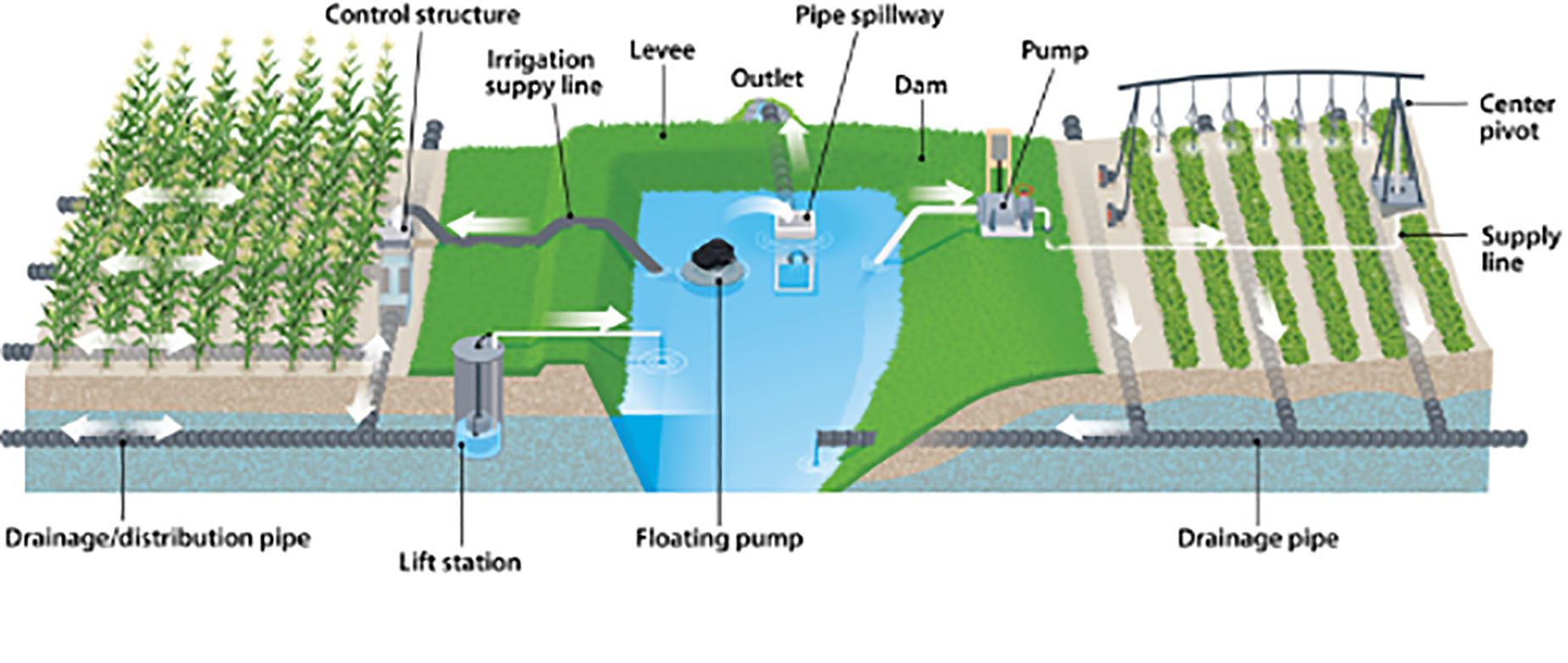
Figure 1. Example potential drainage water recycling (DWR) configurations. Irrigation methods include subirrigation (left), where water is applied back to the field through the drainage system, and sprinkler irrigation (right). (Submitted photo)
Transforming ag drainage: Answers to 6 big questions about drainage water recycling
August 20, 2020
What if you could capture excess water drained from your fields, store this water in a pond or reservoir, and use it to irrigate your crops during dry periods? It’s possible with drainage water recycling (DWR), a forward-looking practice that the Iowa Soybean Association’s (ISA) Research Center for Farming Innovation (RCFI) is studying.
While DWR isn’t new, it’s an idea worth revisiting. “Iowa State University’s (ISU) DWR research in the 1980s showed this system could help improve yields, but the economics weren’t there to justify the investment,” said Chris Hay, senior manager, production systems innovation, at RCFI. “What’s changed today is interest in the other benefits of DWR, including water-quality improvement, wildlife habitat and flood control. There are also cost-share dollars to help make DWR viable.”
Q: How does drainage water recycling work?
A: DWR captures surface and subsurface (tile) drainage water and stores it in a pond or reservoir for reuse as supplemental irrigation during dry periods. There are many potential configurations for DWR systems. Options include sub-irrigation, where water is applied back to the field through the drainage system, and sprinkler irrigation.
“Natural low areas and draws can work well for DWR,” Hay said. “Just block off one side with a dam, and you’ve got a reservoir.” On a flat landscape, it will be necessary to excavate the reservoir, with the spoil used as a levee to increase storage. “It’s possible to make DWR work in about any situation where you can benefit from both drainage and irrigation,” Hay added.
Q: What are the benefits of drainage water recycling?
A: DWR can increase yield and yield stability (resiliency) when conditions are too wet or too dry. DWR can also improve downstream water quality by capturing and recycling drainage water and nutrients (including nitrogen and phosphorus) to nourish crops.
In addition, DWR can provide wildlife habitat and help with downstream flooding control, depending on how the system is designed and managed. “There’s a lot of interest in DWR, because it offers multiple benefits,” Hay said.
Q: What yield benefits can drainage water recycling provide?
A: DWR can increase corn yields up to 61 percent and soybean yields up to 31 percent, based on data from DWR field sites in the Transforming Drainage research project, as well as some earlier research. “However, these results are from a limited number of sites each having unique characteristics, so more research is needed to fully understand the yield benefits that can be achieved with DWR,” said Hay, who noted that ISA is a collaborator on the multi-state Transforming Drainage research project.
DWR field research at a site near Story City, Iowa, has shown average corn yield increases of 53 bushels per acre using DWR, compared to the control treatment. “Yields are also more stable with DWR,” Hay said.
Q: How much does a drainage water recycling system cost?
A: It depends. The two biggest expenses are the reservoir and the irrigation equipment. A low-cost DWR system might be possible for around $100,000, especially if existing infrastructure can be used. “That might be an option if there’s already a pond, or the existing drainage system can be used for a sub-irrigation system without a lot of additional investment,” Hay said. In other cases, $200,000 to $300,000 or more is more likely for a DWR system. “If land has to be taken out of production for the reservoir, that can be another large expense,” Hay noted.
There are cost-share dollars available for these systems through Environmental Quality Incentives Program (EQIP) from the Natural Resources Conservation Service (NRCS). Cost-share to help pay for the reservoir may also be available through the Iowa Department of Agriculture and Land Stewardship (IDALS).
Q: How big does the reservoir need to be?
A: A reservoir of 6 percent to 8 percent of the irrigated field area with an average depth of 10 feet is adequate to fully meet irrigation demands. That’s based on modeling research done in collaboration with researchers from Purdue University and ISU over a 10-year period for a site in Indiana and a site in Iowa, respectively. These modeled DWR systems are also able to reduce nitrogen and phosphorus losses from the field by 20 percent to 35 percent, on average, and up to 70 percent to 80 percent in some years, Hay noted. A deeper reservoir would need less area.
Q: What’s next for drainage water recycling research in Iowa?
A: ISA and ISU are collecting their fourth year of data from the DWR system near Story City. Three more DWR systems will be constructed in Iowa within the next year, including two in Calhoun County and one in Webster County, as part a project with IDALS, ISU and ISA.
For more information on drainage water recycling, visit the Transforming Drainage website (https://transformingdrainage.org) or download the free “Questions and Answers About Drainage Water Recycling for the Midwest” publication from the Purdue Extension store (https://edustore.purdue.edu/abe-156-w.html).
Back